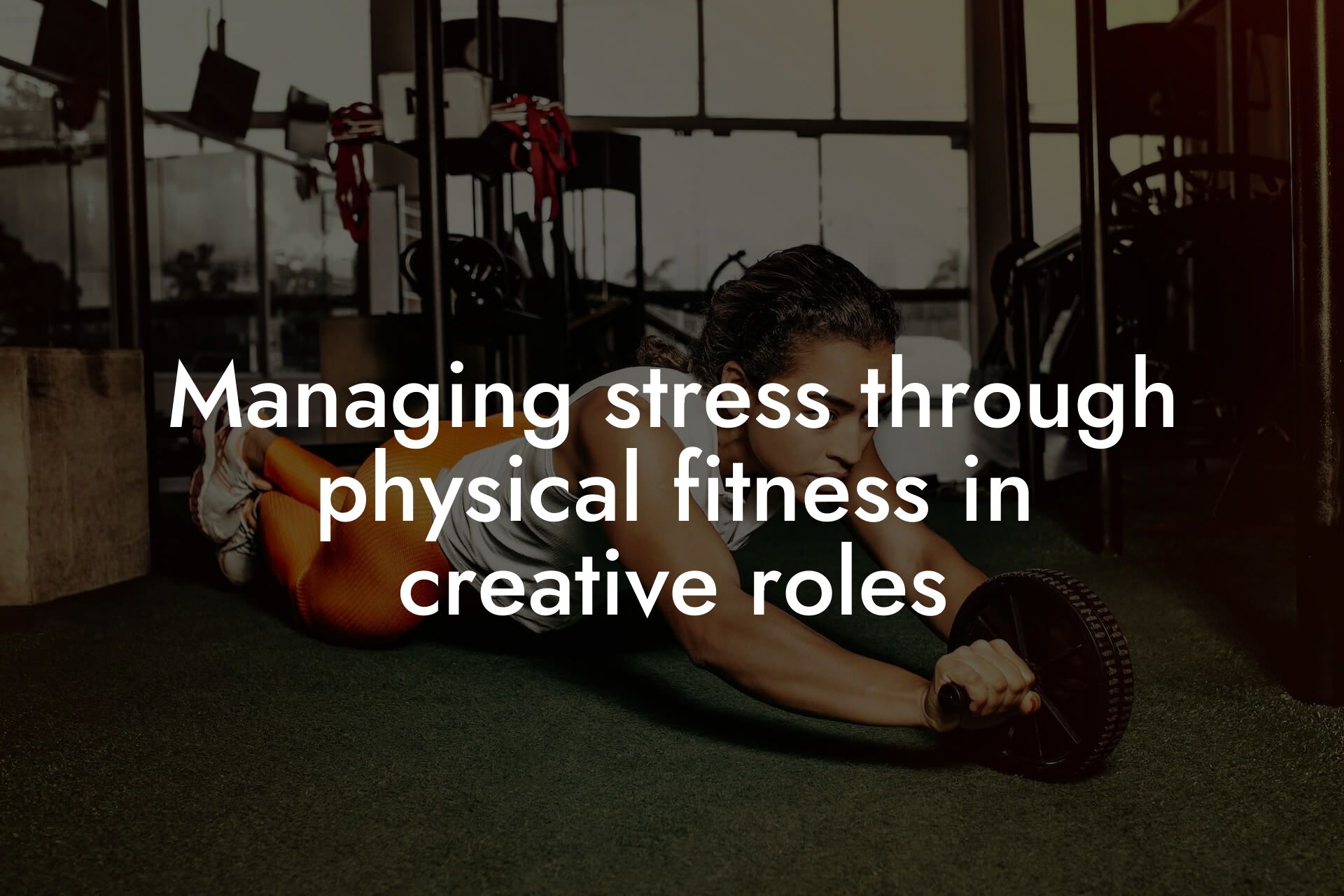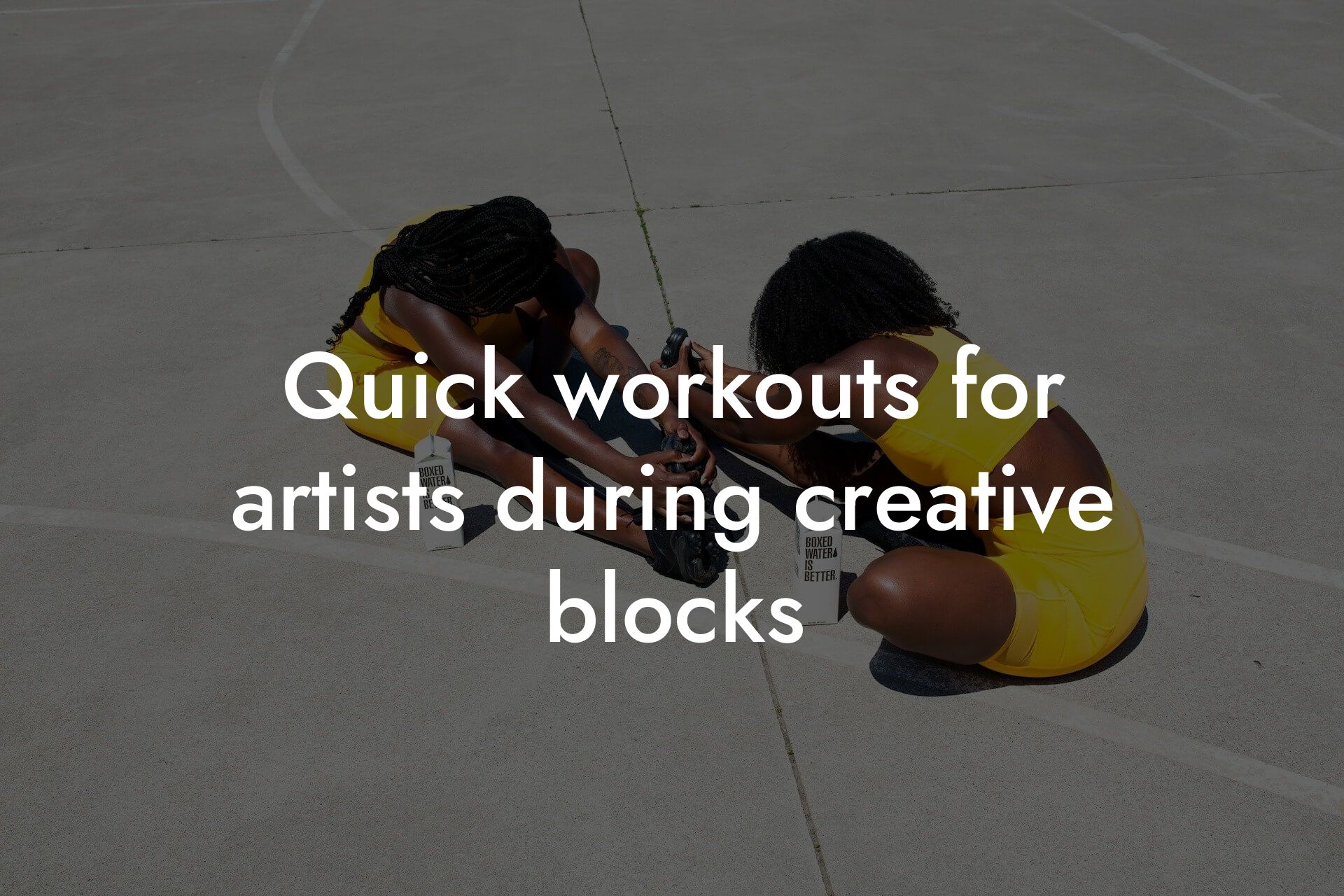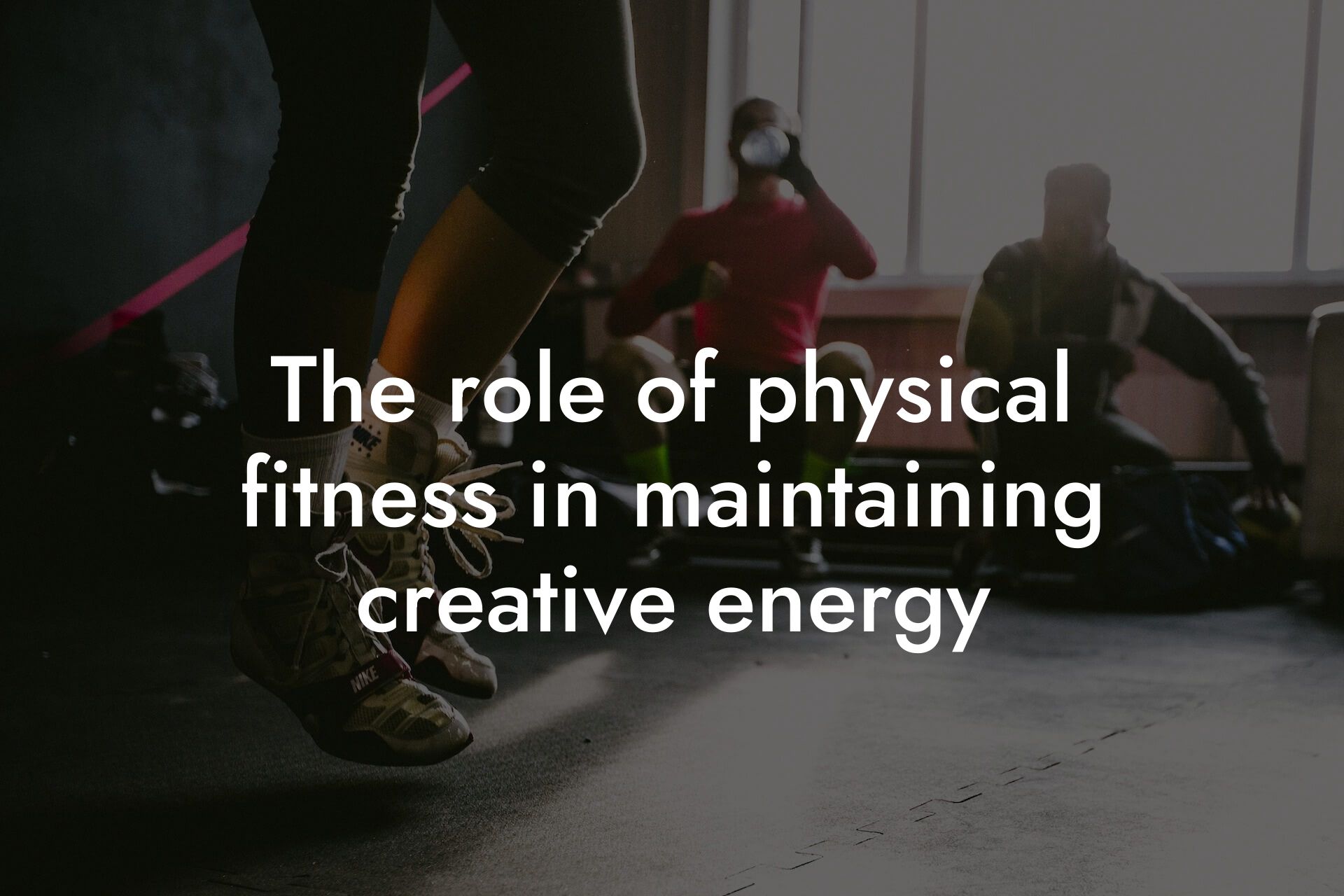As an artist, you know that creating your best work often requires dedicating long hours to your craft. However, spending extended periods in the studio can take a toll on your physical health, leading to fatigue, discomfort, and even injury. At Tano Performance Group, we understand the importance of maintaining a healthy body to support your creative endeavors. In this article, we'll provide you with expert advice on how to stay fit and healthy during long studio sessions.
Table of Contents
Understanding the Risks of Prolonged Sitting
Sitting for extended periods is a common occurrence for many artists, whether you're working on a painting, sculpture, or digital art piece. However, prolonged sitting can lead to a range of negative health effects, including:
- Back and neck pain
- Stiffness and reduced mobility
- Decreased blood flow and oxygenation to the brain
- Increased risk of chronic diseases, such as diabetes and cardiovascular disease
Stretching and Movement Breaks
One of the simplest and most effective ways to combat the negative effects of prolonged sitting is to incorporate regular stretching and movement breaks into your studio routine. Set a timer to remind yourself to stand up and move every 30-60 minutes. Try some of the following exercises:
- Neck stretches: Slowly tilt your head to the side, bringing your ear towards your shoulder, and then back to the starting position. Repeat on the other side.
- Shoulder rolls: Roll your shoulders forward and backward in a circular motion. Repeat for 10-15 repetitions.
- Wrist extensions: Hold your arms straight out in front of you and lift your hands up, then lower them back down. Repeat for 10-15 repetitions.
- Leg stretches: Stand up and lift one leg out to the side, keeping your knee straight. Hold for 10-15 seconds and then lower. Repeat on the other side.
Ergonomic Studio Setup
Your studio setup can greatly impact your physical comfort and overall health. Make sure your workspace is ergonomically designed to promote good posture and reduce strain on your body:
- Adjust your chair height to ensure your feet are flat on the floor or on a footrest, and your knees are at or below hip level.
- Position your monitor directly in front of you, at a distance of about 20-25 inches, and at a height that allows you to gaze slightly downward.
- Keep your workspace clutter-free and organized to reduce the need for excessive reaching or bending.
Nutrition and Hydration
Fueling your body with the right foods and staying hydrated is crucial for maintaining energy and focus during long studio sessions. Aim to eat a balanced diet that includes:
- Complex carbohydrates, such as whole grains, fruits, and vegetables
- Lean protein sources, such as nuts, seeds, and lean meats
- Healthy fats, such as avocado, olive oil, and fatty fish
Stay hydrated by drinking plenty of water throughout the day. Aim for at least 8-10 glasses of water per day, and avoid sugary drinks and caffeine that can lead to energy crashes and decreased focus.
Exercise and Physical Activity
Regular exercise is essential for maintaining overall health and fitness. As an artist, you may not have a traditional 9-to-5 schedule, but that doesn't mean you can't fit in physical activity:
- Try to incorporate at least 30 minutes of moderate-intensity exercise into your daily routine, such as brisk walking, cycling, or swimming.
- Break up your exercise routine into shorter sessions, such as 10-15 minute breaks throughout the day.
- Consider incorporating strength training exercises to improve your overall muscle tone and reduce the risk of injury.
Body Awareness and Posture
Being mindful of your body position and posture can help reduce the risk of discomfort and injury during long studio sessions:
- Take regular breaks to stand up, stretch, and move around.
- Pay attention to your posture, keeping your shoulders relaxed, your head level, and your spine straight.
- Avoid crossing your legs or ankles, which can lead to poor circulation and discomfort.
Stress Management and Mindfulness
Creating art can be a mentally and emotionally demanding process, leading to stress and anxiety. Practicing stress management techniques and mindfulness can help you stay focused and energized during long studio sessions:
- Try incorporating mindfulness exercises, such as deep breathing, meditation, or yoga, into your daily routine.
- Take regular breaks to step away from your work and clear your mind.
- Practice self-compassion and acknowledge that it's okay to take breaks and prioritize your well-being.
DEXA Scanning and Body Composition Analysis
At Tano Performance Group, we understand the importance of tracking your body composition and overall health. Our DEXA scanning technology provides a comprehensive analysis of your body fat percentage, bone density, and lean muscle mass. This information can help you:
- Identify areas for improvement in your diet and exercise routine.
- Track your progress over time and make data-driven decisions about your health.
- Optimize your body composition to improve your overall health and performance.
By incorporating these tips and strategies into your studio routine, you can maintain your physical and mental health, stay focused and energized, and continue to create your best work. Remember, taking care of your body is essential to taking your art to the next level.
Frequently Asked Questions
What are the risks of prolonged sitting for artists?
Prolonged sitting has been linked to various health risks, including obesity, diabetes, cardiovascular disease, and even certain types of cancer. For artists, sitting for extended periods can also lead to musculoskeletal disorders, eye strain, and decreased productivity. It's essential to take regular breaks and incorporate physical activity into your daily routine to mitigate these risks.
How can I stay motivated to exercise during long studio sessions?
Staying motivated to exercise can be challenging, especially when you're in the midst of a creative project. Try setting small, achievable fitness goals for yourself, such as taking a 10-minute walk every hour or doing a few jumping jacks during breaks. You can also find a workout buddy or accountability partner to help keep you motivated.
What are some exercises I can do in my studio to stay active?
There are many exercises you can do in your studio to stay active, even with limited space. Try doing chair squats, desk push-ups, or leg raises while sitting. You can also do some light stretching, yoga poses, or jumping jacks to get your heart rate up and loosen your muscles.
How can I incorporate mindfulness into my exercise routine?
Mindfulness can be a powerful tool for staying motivated and focused during exercise. Try paying attention to your breath, posture, and body alignment as you move. You can also listen to guided meditations or calming music to help you stay present and centered.
What are some healthy snack options for artists?
Healthy snacking is essential for maintaining energy and focus during long studio sessions. Opt for nutrient-dense snacks like nuts, fruits, carrot sticks with hummus, or energy bars made with wholesome ingredients. Avoid sugary or processed snacks that can lead to energy crashes and decreased productivity.
How can I stay hydrated during long studio sessions?
Staying hydrated is crucial for maintaining focus, energy, and overall health. Aim to drink at least 8-10 glasses of water per day, and consider keeping a refillable water bottle nearby. You can also consume hydrating foods like watermelon, cucumbers, and celery to help meet your daily hydration needs.
What are some common mistakes artists make when it comes to exercise and fitness?
One common mistake artists make is neglecting to prioritize exercise and fitness due to busy schedules or creative demands. Others may overexert themselves, leading to injury or burnout. It's essential to find a balance between creative pursuits and physical activity to maintain overall well-being.
How can I create a workout routine that fits my busy schedule?
Creating a workout routine that fits your busy schedule requires flexibility and creativity. Try breaking up your workout into shorter sessions, such as 10-15 minute increments, and prioritize exercises that can be done in a small space, like bodyweight exercises or yoga poses.
What are some benefits of exercise for artists?
Exercise offers numerous benefits for artists, including increased energy, improved focus, and enhanced creativity. Regular physical activity can also reduce stress and anxiety, improve mood, and boost self-confidence.
How can I make exercise a habit?
Making exercise a habit requires consistency, commitment, and accountability. Try scheduling exercise into your daily routine, finding a workout buddy, or tracking your progress to stay motivated. Celebrate small victories and don't be too hard on yourself if you miss a day – simply get back on track and keep moving forward.
What are some exercises that can help improve posture?
Exercises that can help improve posture include shoulder rolls, chest opens, and spinal extensions. You can also try doing exercises that strengthen your core, such as planks or bridges, to improve your overall posture and reduce back pain.
How can I reduce eye strain during long studio sessions?
Reducing eye strain during long studio sessions requires regular breaks, proper lighting, and good posture. Try following the 20-20-20 rule: every 20 minutes, look away from your screen and focus on something 20 feet away for 20 seconds. You can also adjust the brightness and contrast of your screen to reduce eye strain.
What are some stretches I can do to relieve tension in my neck and shoulders?
Relieving tension in your neck and shoulders can be achieved through simple stretches like shoulder rolls, neck stretches, and chest opens. Try doing these exercises regularly, especially during breaks, to reduce muscle tension and improve your overall posture.
How can I prioritize self-care during long studio sessions?
Prioritizing self-care during long studio sessions requires intentional breaks, healthy snacking, and regular exercise. Try taking short breaks to meditate, practice deep breathing, or engage in activities that bring you joy and relaxation.
What are some common injuries artists experience due to prolonged sitting?
Common injuries artists experience due to prolonged sitting include carpal tunnel syndrome, tendonitis, and lower back pain. These injuries can be prevented or mitigated by taking regular breaks, exercising regularly, and maintaining good posture.
How can I stay energized during long studio sessions?
Staying energized during long studio sessions requires a combination of regular exercise, healthy snacking, and adequate hydration. Try incorporating energizing activities, such as short walks or stretching exercises, into your breaks to help boost your energy levels.
What are some exercises that can help improve my overall flexibility?
Exercises that can help improve your overall flexibility include yoga poses, Pilates, and dynamic stretching. Try incorporating these exercises into your routine, especially during breaks, to improve your range of motion and reduce muscle tension.
How can I create a workout routine that fits my artistic style?
Creating a workout routine that fits your artistic style requires understanding your creative needs and preferences. Try incorporating exercises that stimulate your creativity, such as movement-based activities or exercises that challenge your coordination and balance.
What are some benefits of mindfulness for artists?
Mindfulness offers numerous benefits for artists, including increased focus, improved creativity, and reduced stress and anxiety. Regular mindfulness practice can also help artists develop a greater sense of self-awareness and self-acceptance.
How can I incorporate physical activity into my daily routine as an artist?
Incorporating physical activity into your daily routine as an artist requires creativity and flexibility. Try scheduling exercise into your daily routine, finding a workout buddy, or incorporating physical activity into your creative process, such as using movement-based exercises to stimulate your creativity.
What are some common myths about exercise and fitness for artists?
Common myths about exercise and fitness for artists include the idea that exercise will distract from creative pursuits or that artists are not athletic. These myths can be debunked by understanding the numerous benefits of exercise for artists, including increased energy, improved focus, and enhanced creativity.
How can I track my progress and stay motivated?
Tracking your progress and staying motivated requires setting clear goals, tracking your progress, and celebrating small victories. Try using a fitness tracker, journaling your progress, or finding a workout buddy to help keep you motivated and accountable.
What are some exercises that can help improve my balance and coordination?
Exercises that can help improve your balance and coordination include yoga poses, tai chi, and balance exercises like single-leg squats. Try incorporating these exercises into your routine, especially during breaks, to improve your overall balance and coordination.
How can I prioritize my physical health as an artist?
Prioritizing your physical health as an artist requires understanding the importance of exercise and fitness for overall well-being. Try scheduling exercise into your daily routine, incorporating physical activity into your creative process, and prioritizing healthy snacking and hydration to maintain your physical health.
Here are some related articles you might love...
- Managing stress through physical fitness in creative roles
- Quick workouts for artists during creative blocks
- The role of physical fitness in maintaining creative energy
- Nutrition strategies for fueling creative work
- Balancing artistic work with personal fitness goals
- How to maintain bone density in sedentary artistic jobs
- How DEXA scans can benefit creative professionals
- The impact of body composition on creative performance
- The connection between physical health and creative output
Zak Faulkner
Zak Faulkner is a leading authority in the realm of physical health and body composition analysis, with over 15 years of experience helping professionals optimise their fitness and well-being. As one the experts behind Tano Performance Group, Zak has dedicated his career to providing in-depth, science-backed insights that empower clients to elevate their physical performance and overall health.
With extensive knowledge of DEXA technology, Zak specializes in delivering comprehensive body assessments that offer precise data on body fat, muscle mass, bone density, and overall physique. His expertise enables individuals to make informed decisions and achieve their fitness goals with accuracy and confidence. Zak’s approach is rooted in a deep understanding of human physiology, combined with a passion for helping clients unlock their full potential through personalised strategies.
Over the years, Zak has earned a reputation for his commitment to excellence, precision, and client-focused service. His guidance is trusted by top professionals who demand the best when it comes to their health. Whether advising on fitness programs, nutritional strategies, or long-term wellness plans, Zak Faulkner’s insights are a valuable resource for anyone serious about taking their health and fitness to the next level.
At Tano Performance Group, Zak continues to lead our Content Team revolutionising how professionals approach their physical health, offering unparalleled expertise that drives real results.




